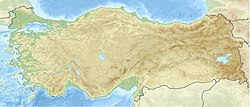1968 Bartın earthquake
In this article we will explore the fascinating world of 1968 Bartın earthquake, about which very little is known. 1968 Bartın earthquake has been the subject of debate and study for years, but there are still many mysteries to be solved. From its origin to its impact on society, 1968 Bartın earthquake has left an indelible mark on history. Through this article, we will delve into the most intriguing and unknown details about 1968 Bartın earthquake, discovering its importance and relevance in different aspects of daily life. Get ready for a deep dive into the universe of 1968 Bartın earthquake, where you will be able to learn all the relevant data and curiosities that will surprise you.
| UTC time | 1968-09-03 08:19:56 |
|---|---|
| ISC event | 816634 |
| USGS-ANSS | ComCat |
| Local date | September 3, 1968 |
| Local time | 10:19:56 |
| Magnitude | 6.2 Mw(ISC) |
| Depth | 20 km (12 mi)[1] |
| Epicenter | 41°52′N 32°28′E / 41.86°N 32.46°E[1] |
| Type | Thrust[2] |
| Max. intensity | MMI VIII (Severe)[3][4] |
| Tsunami | One runup at 3 metres (9.8 ft)[4] |
| Casualties | 24–29 deaths and 200 injured[4] |
The 1968 Bartın earthquake occurred at 10:19:56 on September 3 with a moment magnitude of 6.3 and a maximum Mercalli Intensity of VIII (Severe). The thrust shock resulted in 24 to 29 deaths and 200 injuries. A tsunami was generated in the Black Sea with a maximum runup height of 3 metres (9.8 ft). A comprehensive catalogue of tsunamis on the Turkish coast lists the 1968 Amasra event as a definite tsunami, noting inundation distances of 50–100 m along the Amasra–Çakraz shoreline, and ranks it among the most significant Black Sea tsunamis of the 20th century.[5]
Earthquake
The shock originated on the coast of the Black Sea near Amasra and damage to stone masonry homes was considered heavy between Amasra and Bartin. Ground effects included rock slides, liquefaction, and downslope spreading near rivers. Beaches were raised 40 centimetres (16 in) near Amasra and Cape Cakraz, and a 3 metres (9.8 ft) tsunami caused flooding.[6]
In addition to the heavy damage to stone masonry homes between Amasra and Bartın and the tsunami run-up, seismological studies show that the mainshock resulted from movement on a shallow, southeast-dipping thrust fault beneath the southern Black Sea margin. A thrust fault is a type of reverse fault in which the upper crustal block is pushed up and over the lower block. Waveform inversions of long-period compressional (P) and shear (SH) waves indicate the fault plane strikes roughly northeast–southwest (strike ≈ 28°), dips at about 38° to the southeast and slipped with a near-vertical motion (rake ≈ 80°). The average depth of slip (centroid depth) was only ≈ 4 km, and released about 3.9 × 1025 dyn·cm of seismic moment—a standard measure of an earthquake's total energy—which corresponds to a moment magnitude of 6.3.[2]
Strong aftershock activity followed: nine aftershocks of magnitude 4.0–4.6 were reported by the International Seismological Centre, five of which occurred on the day of the mainshock. At the nearest station in Kastamonu (roughly 120 km southeast), 256 aftershocks were recorded in the first 24 hours and over 500 within the first week, contributing to widespread alarm and hampering rescue and recovery efforts.[2]
Field observations immediately after the earthquake documented up to 0.4 m of coastal uplift near Amasra and numerous landslides, cracks in alluvial deposits and localised ground liquefaction, consistent with the inferred reverse-fault motion. Geological mapping and multichannel seismic reflection profiles show a system of southeast-dipping reverse faults running roughly parallel to the modern coastline about 10 km offshore, implicating active north–south compression of this back-arc basin margin.[2]
See also
References
- ^ a b ISC (27 June 2022), ISC-GEM Global Instrumental Earthquake Catalogue (1900–2009), Version 9.1, International Seismological Centre, doi:10.31905/D808B825
- ^ a b c d Alptekin, Ömer; Nábĕlek, John L; Toksöz, M.Nafi (1986), "Source mechanism of the Bartin earthquake of September 3, 1968 in northwestern Turkey: Evidence for active thrust faulting at the southern Black Sea margin", Tectonophysics, 122 (1–2): 73–88, Bibcode:1986Tectp.122...73A, doi:10.1016/0040-1951(86)90159-9, ISSN 0040-1951
- ^ PAGER-CAT Earthquake Catalog, Version 2008_06.1, United States Geological Survey, September 4, 2009
- ^ a b c National Geophysical Data Center (1972), "National Geophysical Data Center / World Data Service (NGDC/WDS)", Global Significant Earthquake Database, NOAA National Centers for Environmental Information, doi:10.7289/V5TD9V7K
- ^ Altınok, Y.; Ersoy, Ş. (2000). "Tsunamis Observed on and Near the Turkish Coast". Natural Hazards. 21: 185–205. doi:10.1023/A:1008130512498.
- ^ Ambraseys, N. N. (1988). "Engineering seismology: Part II". Earthquake Engineering & Structural Dynamics. 17 (1): 56, 57. Bibcode:1988EESD...17...51A. doi:10.1002/eqe.4290170102. ISSN 0098-8847.
- Albers, John Patrick; Kalifatcioglu, Adnan (1972), "Bartin-Amasra earthquake, Turkey, September 3, 1968", Open-File Report, United States Geological Survey, doi:10.3133/ofr723, ISSN 2331-1258
- Yalçın, D.; Sertçelik, F. (2017). "Comparison of 1968 Bartın Earthquake Isoseismal Map And Scenario Earthquake Intensity Maps By Using Gis". 9th Congress of the Balkan Geophysical Society. Netherlands: EAGE Publications BV. doi:10.3997/2214-4609.201702569. ISBN 978-94-6282-236-8. ISSN 2214-4609.
